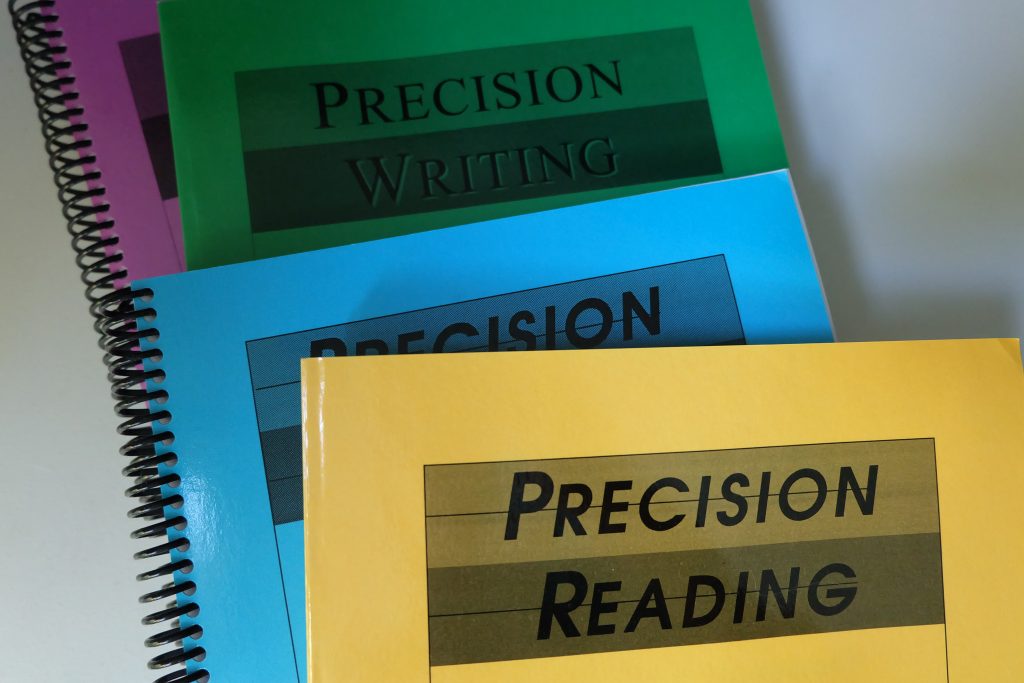
The Books
The Precision Reading program is comprised of the Instructors’ Handbook and Instructors’ Sourcebook, which are normally purchased as a set.
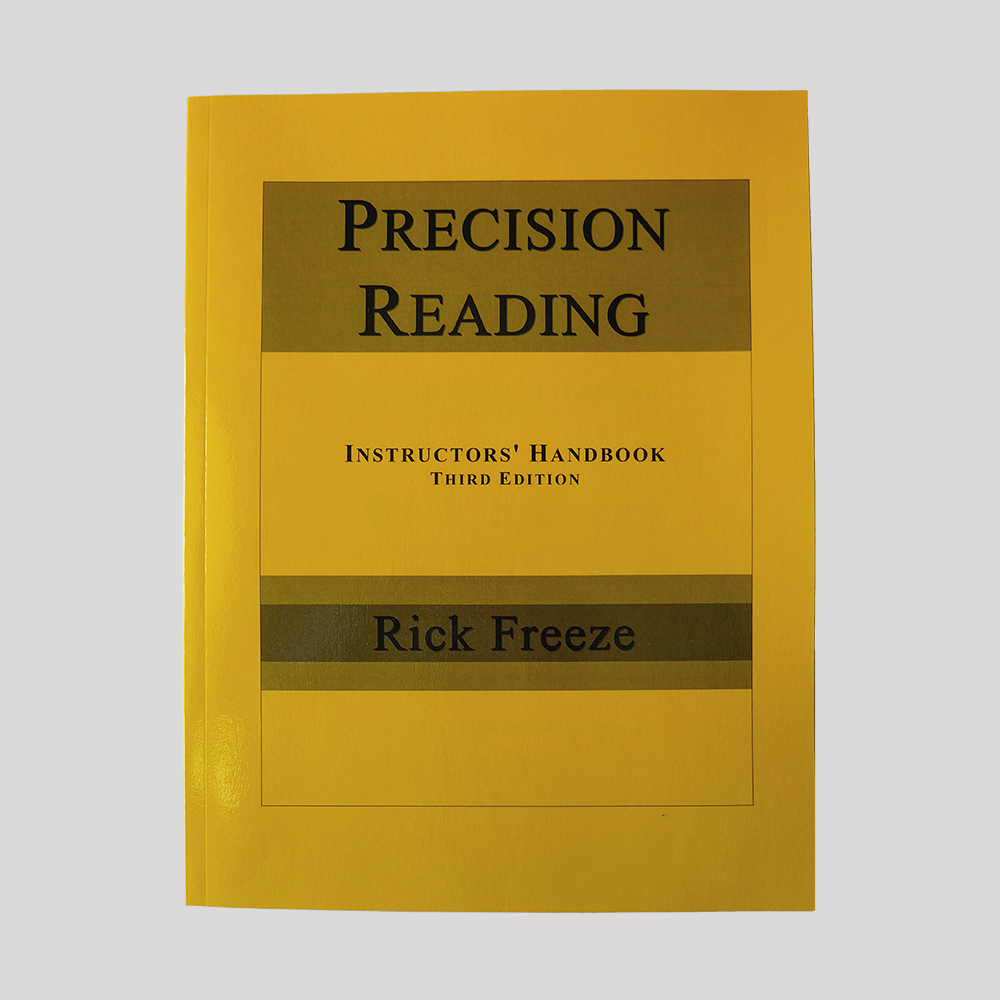
Instructors’ Handbook
The Handbook describes how to do Precision Reading and explains why it works.
Chapters:
- Introduction to Precision Reading
- The Core Strategy
- The Support Strategies
- The Comprehension Strategies
- Teaching Non-Readers to Read
- Assessment and Program Implementation
Number of Pages: 249
Binding: Perfect Bound
Click here for more details.
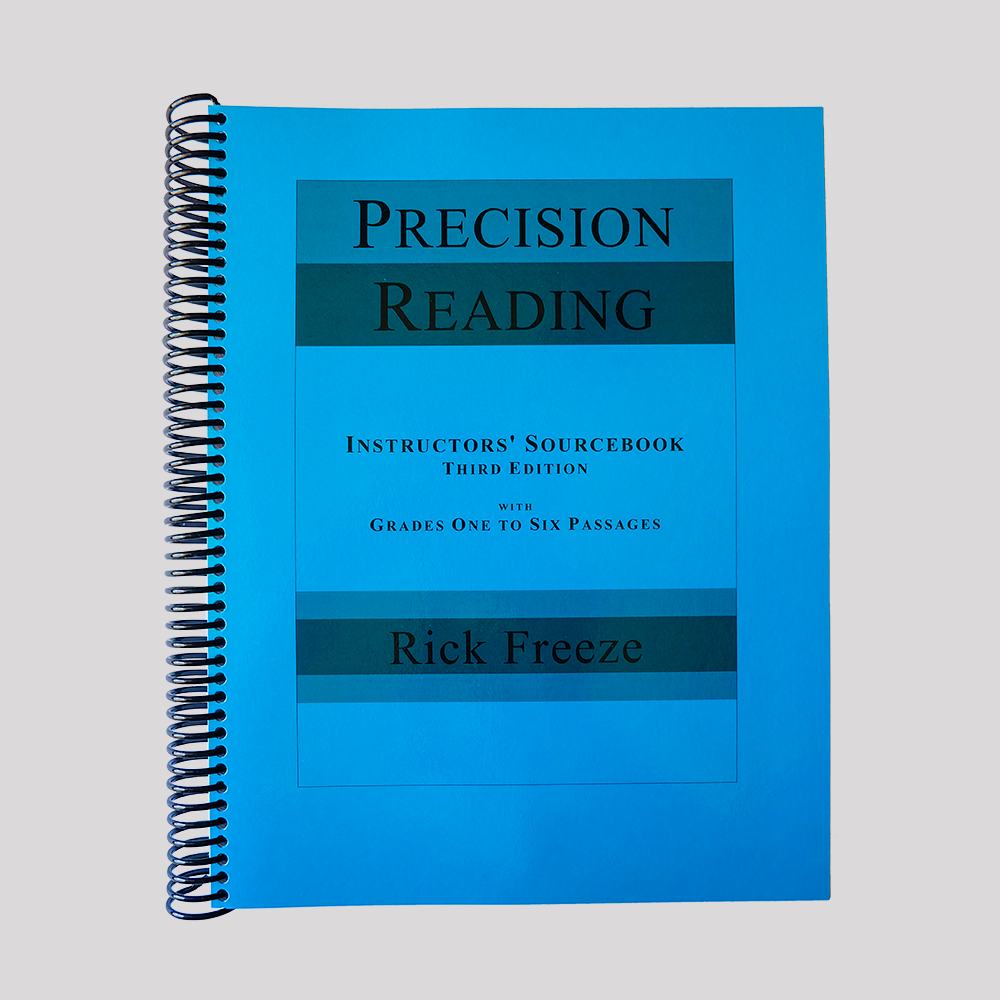
Instructors’ Sourcebook with Grades One to Six Passages
This Sourcebook contains useful resource materials for implementing Precision Reading in Grades One to Six.
Chapters:
- Graphs
- Core Strategy Record Forms
- Strategy Checklists and Forms
- Formatted Passages
Number of Pages: 365
Binding: Spiral Bound for easier copying
Click here for more details.
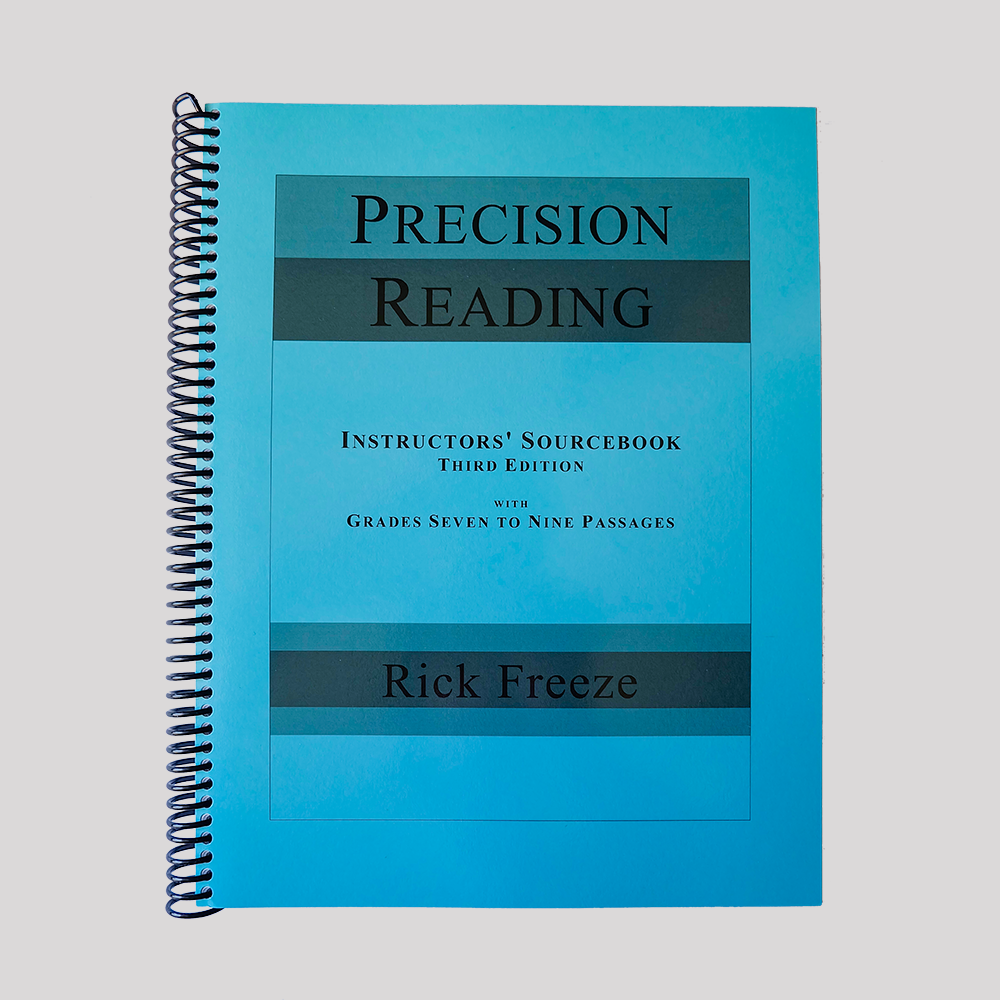
Instructors’ Sourcebook with Grades Seven to Nine Passages
This Sourcebook contains useful resource materials for implementing Precision Reading in Grades Seven to Nine.
Chapters:
- Graphs
- Core Strategy Record Forms
- Strategy Checklists and Forms
- Formatted Passages
Number of Pages: 321
Binding: Spiral Bound for easier copying
Click here for more details.
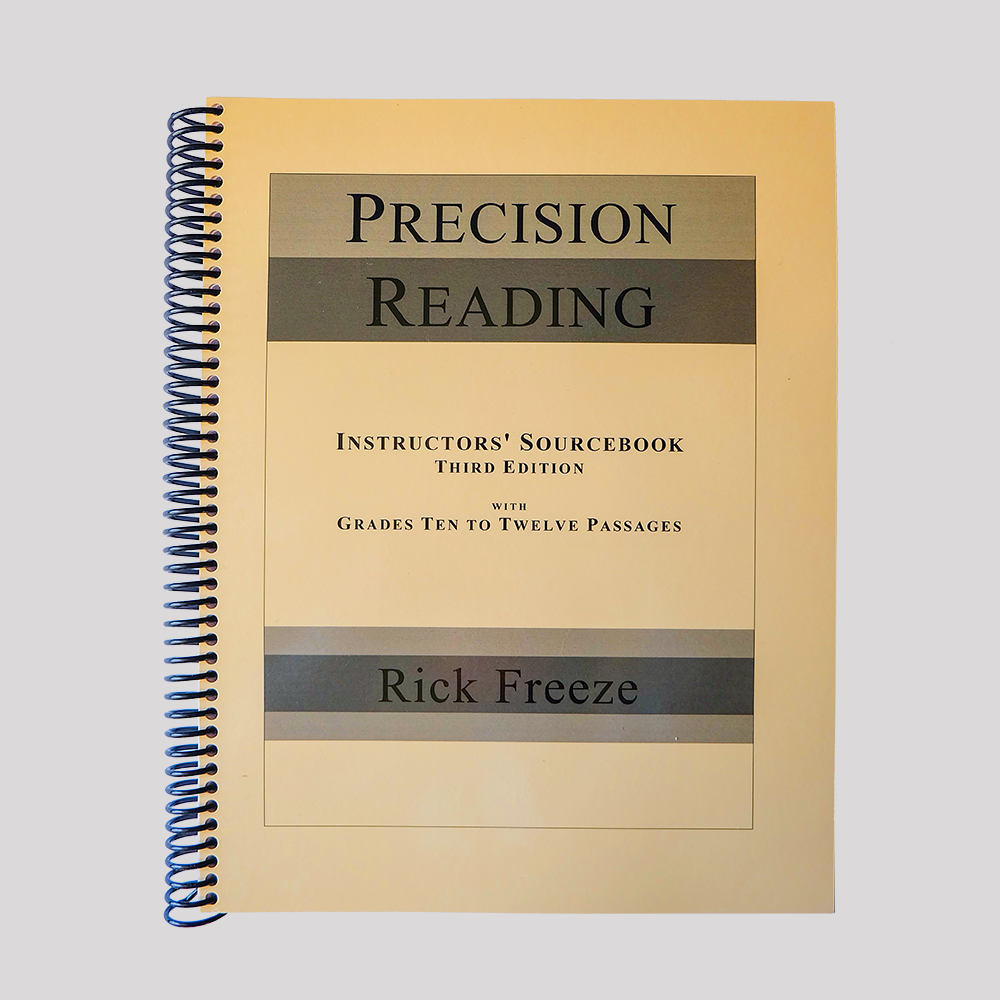
Instructors’ Sourcebook with Grades Ten to Twelve Passages
This Sourcebook contains useful resource materials for implementing Precision Reading in Grades Ten to Twelve.
Chapters:
- Graphs
- Core Strategy Record Forms
- Strategy Checklists and Forms
- Formatted Passages
Number of Pages: 279
Binding: Spiral Bound for easier copying
Click here for more details.
Who Benefits from Precision Reading?
Precision Reading will work with almost any student at any grade level. It has been used successfully with a wide variety of students in the early, middle, and senior grades and in adult education. Students do not need to have disabilities to benefit from Precision Reading.
Students described as
- Reluctant readers
- Non-readers
- Unmotivated readers
- Resistant readers
- English as Second Language (ESL) learners
- English Language Learners (ELL)
- Refugee or Immigrant English learners
- Struggling learners in French, French Immersion, and other languages
Students with
- Learning Disabilities
- Attention Deficit Hyperactivity Disorder (ADHD and ADD)
- Fetal Alcohol Syndrome (FAS)
- Intellectual disabilities (e.g. Down’s Syndrome, Autism, etc.)
- Language Delay
- Severe social, emotional, and behavioural problems
- Attention and memory problems
Precision Reading can be used in English, French, French Immersion, First Nation, and English as a Second Language (ESL) classrooms. It is not recommended for students who are frequently absent from school, individuals with speech impairments or those who are mute, hard of hearing, deaf or blind. It is not effective with students with disabilities that preclude them from learning communication symbols.
Improved Areas
Precision Reading is a new, inexpensive, short, daily, research-based reading activity that quickly improves students’ abilities in the following key areas.

Passage Comprehension
Over time, leads to much better retelling, summarization, prediction, interpretation, analysis, questioning and critical thinking.

Word Recognition and Comprehension
Expect improved word recognition and comprehension, for both high frequency sight words and curriculum-related content vocabulary.

Reading Automaticity
Expect dramatic increases in reading speed, accuracy, smoothness, comprehension, retention and comprehension.
10 Components
These components are integral to the Precision Reading program.
1. Student Profile
A quick and easy student profile to assess who needs Precision Reading and to track student progress over time.
2. Three Levels of Reformatting
Three levels of reformatting to adapt classroom reading materials and make them more accessible to below grade level readers, without sacrificing vocabulary, content, or relevance to classroom instruction and the curriculum.
3. Core Reading Strategy
A core reading strategy, used at every daily session, to build reading fluency (speed, accuracy and smoothness) through supported repeated readings, automaticity training and positive feedback.
4. Word Practice
A word practice procedure, used at every daily session, to build a large sight word vocabulary through a visual memory strategy designed to put words permanently into long term memory.
5. Three Retelling Strategies
A choice of three retelling comprehension strategies to teach and support students with reading comprehension and information retention problems, including students with intellectual disabilities, low language development or little prior reading experience.
6. Support Strategies
A variety of support strategies to enable students with intellectual disabilities, memory problems, large reading skills deficits, or low motivation to expand their sight vocabularies and read passages fluently, with comprehension, at grade level.
7. Daily Progress Tracking
Easy graphing of daily progress in fluency and word comprehension to motivate students through authentic assessment. Easy recording of retelling capabilities to indicate passage comprehension.
8. Long-Term Progress Tracking
A simple system of long term record keeping to motivate students, inform and assure parents, monitor progress and contribute to student evaluation.
9. Achievement Reinforcement
Achievement reinforcement to initiate, maintain, and enhance positive student attitude, commitment and engagement.
10. Complementary Strategies
Complementary strategies to enhance, extend, and generalize reading skills in the classroom and to increase time-on-task, and the love of reading.
Educational Assistants, Tutors and Parents
The information below is useful for educational assistants (paraeducators), parents and tutors considering the Precision Reading and Precision Writing programs.
Who has it been used by?
Precision Reading and Precision Writing have been used successfully by parents of children at all grade levels in a variety of ways. They can be used to support students reading and writing in language arts and other curricular content areas such as science and social studies. They also can be used to help students who have fallen behind to recover to grade level, using grade level materials from their classrooms. In addition, they help students with intellectual, learning, and other disabilities to keep up with their classmates in reading and writing.
How are the Precision Reading and Precision Writing programs used?
Some parents elect to do Precision Reading with their children or teenagers each school day for five minutes. It is best to do it at the same time and in the same place each day, so Precision Reading becomes a family routine.
The Precision Writing program offers parents step by step guidance in supporting the writing process from start to finish. At each step, there are many writing scaffolds to choose from. Templates for the most common kinds of writing assignments are provided.
Some parents hire a high school, college, or university student to tutor their children in Precision Reading or Precision Writing on a daily basis. This can be done at home or online. Parents and tutors need to read the books and follow the easy step-by-step directions.
In some cases, parents work together with the school to implement a Precision Reading or Precision Writing program that takes place both at home and at school. Contact with the school can be initiated and maintained through the classroom teacher, a teaching assistant, a resource teacher, a special educator, or a reading specialist. Both programs are useful for home schooling.
How easy are the Precision Reading and Precision Writing programs to use?
The Precision Reading method is easy to learn for both you and your son, daughter or tutee. It works best if the passages selected for Precision Reading are properly formatted as explained in the Precision Reading: Instructors’ Handbook. There are preformatted passages on interesting topics related to the curriculum at every grade level in the Precision Reading: Instructors’ Sourcebook.
It is also important to use materials from your son’s, daughter’s or tutee’s grade level classroom reading assignments such as text books, in-class library books, and other home reading and study materials. Some adolescents and adults enjoy doing Precision Reading with passages in high interest areas such as sports, entertainment, travel or hobbies.
Writing is a difficult, complex and frustrating process for many students. Precision Writing provides students with a step by step method that is easy to teach and easy to learn. In addition, at each step, there are scaffolds, templates and checklists that provide guidance and support to overcome the roadblocks students frequently encounter. The Precision Writing: Instructors’ Handbook explains the writing process, while the Precision Writing: Instructors’ Sourcebook provides user-friendly resources to employ throughout the writing process.
Who benefits from the Precision Reading and Precision Writing programs?
While students do not need to have reading or writing problems to benefit from Precision Reading and Precision Writing, students with learning problems and disabilities may benefit most in terms of improved attitude, motivation, and reading and writing skills. When implementing Precision Reading, it may be necessary to add five to ten minutes to each daily session for some students with severe learning or intellectual disabilities as they may need additional support and comprehension strategies. Similarly, during Precision Writing, students with more severe disabilities may need more time to complete and/or more repetitions of the Sourcebook support strategies, necessitating extra time at each step in the writing process.